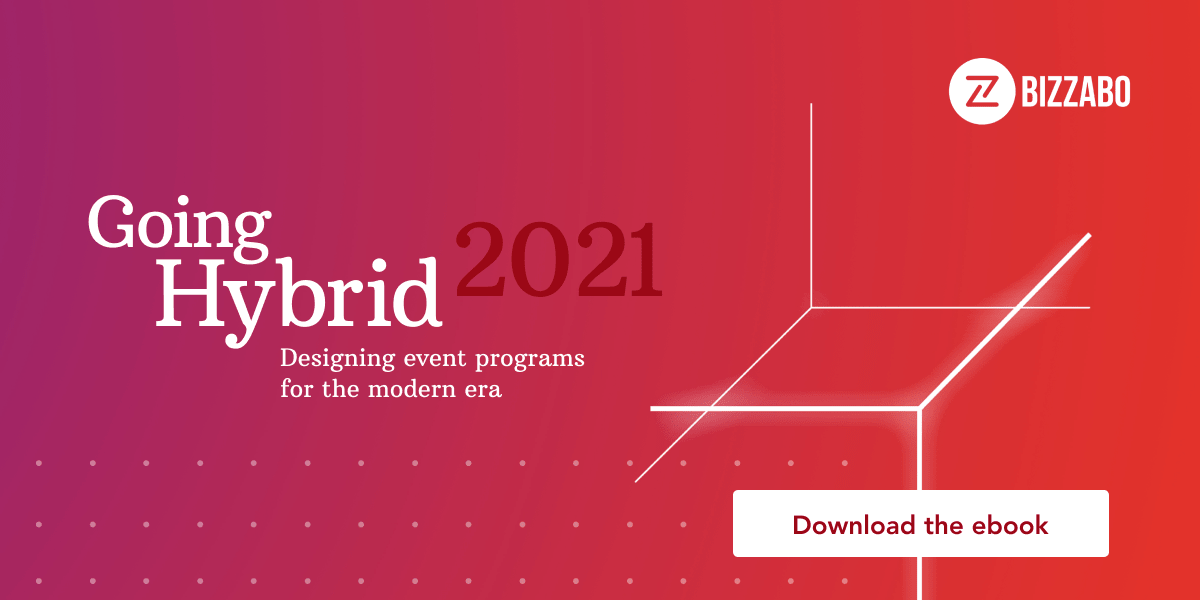From the network model to the single site, discover three hybrid event models for bringing your hybrid event programs to life.
Since COVID-19 changed the way we plan (as well as everything else in life), the concept of the hybrid event has been floated more seriously as we consider how in-person events might function in the future. But what is a hybrid event, and what are some of the advantages it provides for you, your attendees, and your sponsors?
Hybrid events “have elements of in-person and elements of virtual being woven together,” says Bizzabo’s Director of Events, Rachel Ruggieri. An in-person event that’s simply live-streamed doesn’t cut it—“there has to be interaction,” says Rachel.
The exciting thing about planning events right now is that kind of interaction can take so many different forms. One report from Event Manager Blog on the state of the event industry predicts the future will be “overwhelmingly hybrid”, and we’ve seen first-hand how experts are predicting a hybrid future and
For more information on the tools, teams, and processes needed for the hybrid event future, check out the most recent edition of our Going Hybrid Guide.
Over the past year, through conversations with event customers and the larger community of event professionals, we’ve come to see a few foundational models emerge for the future of hybrid events. These models, while perhaps developed out of necessity, have evolved into their own unique experiences that will continue to reach audiences the world over.
The following three hybrid event types each have their own advantages, depending on the kind of experience you’re hoping to create for your audience.
Single Site
Definition: The Single Site hybrid event is one central in-person event with a virtual reproduction that reaches a wider audience. This is the bread and butter of hybrid events, but that doesn’t mean it needs to be basic, and the key to making this event truly hybrid is to facilitate interaction between the audience segments. This event, when done well, can be a great budget-friendly revenue-driver.
At Empower21, the organizers hosted a single site conference that provided networking opportunities and unique experiences for virtual attendees. But the applications of a single site go beyond a conference. Think of the energy and intimacy of a company-wide all-hands or sales kick-off: some people in the room, so the speaker has someone to play off, and virtual interaction between remote employees.
Advantages:
- With most attendees tuning in remotely, you’ll be able to save budget on items like venue, food, and rentals
- Your event is open to more stakeholders, but there are fewer people to manage in person
- Likewise, the AV set-up will be simpler than some of the other models referenced here since only one on-site AV team is required
- Being able to engage with each other in person, your speakers will create a unique dynamic and environment that translates really well to remote viewers
Challenges:
- With many attendees tuning in virtually, you will face the typical challenges around virtual events: keeping attendees engaged, supporting networking opportunities,
- To make the experience truly hybrid you will want to find creative ways to connect virtual and in-person attendees through shared conversation experiences

Network
Definition: A series of smaller concurrent in-person events that gather virtually. This model enables face-to-face networking combined with a potential global digital reach. Technology is a major factor here in bridging the gap between the local gatherings, through outlets like social media or other apps.
Looking to our hybrid event examples, the Junction 2020 hackathon best captures this concept—with a network of 30 distributed hackathons competing simultaneously across the globe. Happy-hour meetups, roundtable events, or industry-specific speaking engagements would all likewise be a good use case for this model. Think events that rely on face-to-face interaction, making connections, and bouncing ideas off colleagues.
Advantages:
- Participants can engage in in-person networking, something that is typically harder to come by in virtual-only events
- While these events can be designed with local or regional needs in mind, the learnings come on a global scale
- Smaller venue needs, and the ability to more easily follow safety protocols
Challenges
- Balancing interaction between your single on-site groups and the larger network of groups
- To keep all of the groups engaged, you will want strong hybrid event teams on the ground at each location
- A multi-site event requires multi-site logistics, including food and beverage and AV

Hub and Spoke
Definition: A combination of the other two hybrid event types, this model features a central in-person event broadcasted out to many smaller in-person offshoots in different locations. The hub and spoke model provides the excitement of a major event, and the reach of a virtual event with face-to-face network capabilities for everyone.
Between the hub and the different spokes, the event serves as both the keynote and breakout rooms, and would work well for any kind of major convention-style event. The hub interacts with all of the spokes, and the spokes interact with each other, creating both a large event and several intimate gatherings.
Advantages:
- The ability to apply a more intimate and personal face-to-face experience while still hosting a large event
- The potential to maximize attendance, which means you could have more pull to access bigger speakers
- You’re able to create the feel of a major event where people can connect but from any city around the world
Challenges:
- Budgets will be higher for this type of event, requiring logistics both a full-blow single-site event and several smaller events
- This type requires quite a bit of coordination, so communication will have to be strong between all of the teams in order to fully facilitate interaction between the audiences
- A multi-site event requires multi-site logistics, including food and beverage and AV

Now that you’re aware of some of the hybrid event types, think about how each one can serve you. One way to help you choose your event type is to first get clear on the ultimate goal of your event.
“Objectives should be closely tied to outcomes,” says Rachel. “Work backward based on the needs of your attendees and sponsors.” For example, if stakeholders want the ability to meet many major players in person, the Single Site model won’t work for you. If an agency is concerned about safety protocols, a Broadcasted event might feel too risky.
“Think of the outcomes and the impact,” says Rachel. If you have a conference or a thought leadership event, consider the Networking model, because it enables your attendees to make meaningful connections with other industry leaders. “This model gives you the ability to curate who’s in the room,” says Rachel, which in turn allows you to ensure success for your attendees.
How you are budgeting for hybrid events will also come into play with this decision. Saving on one large event venue could help you create a greater impact in multiple smaller meet-up spaces. An intimate venue might also be advantageous for the right sponsors, who could design the environment in line with their brand.
No matter what event type you choose—from hybrid to virtual to in-person—all models are simply tools for driving business outcomes. And hybrid events continue to provide all the advantages of both in-person (ticket revenue, immersive activations) and virtual (analytics that prove event sponsorship value, global reach).
Despite all the unknowns, setting yourself up for success by choosing the appropriate model for your event is the best place to start. “You could look at it as a money pit,” says Rachel. “Or it can be a really conscious, weighted effort towards a great and new level of success.”
Download the Going Hybrid Guide for more on getting the most out of your hybrid strategy.
Click here to see original post


